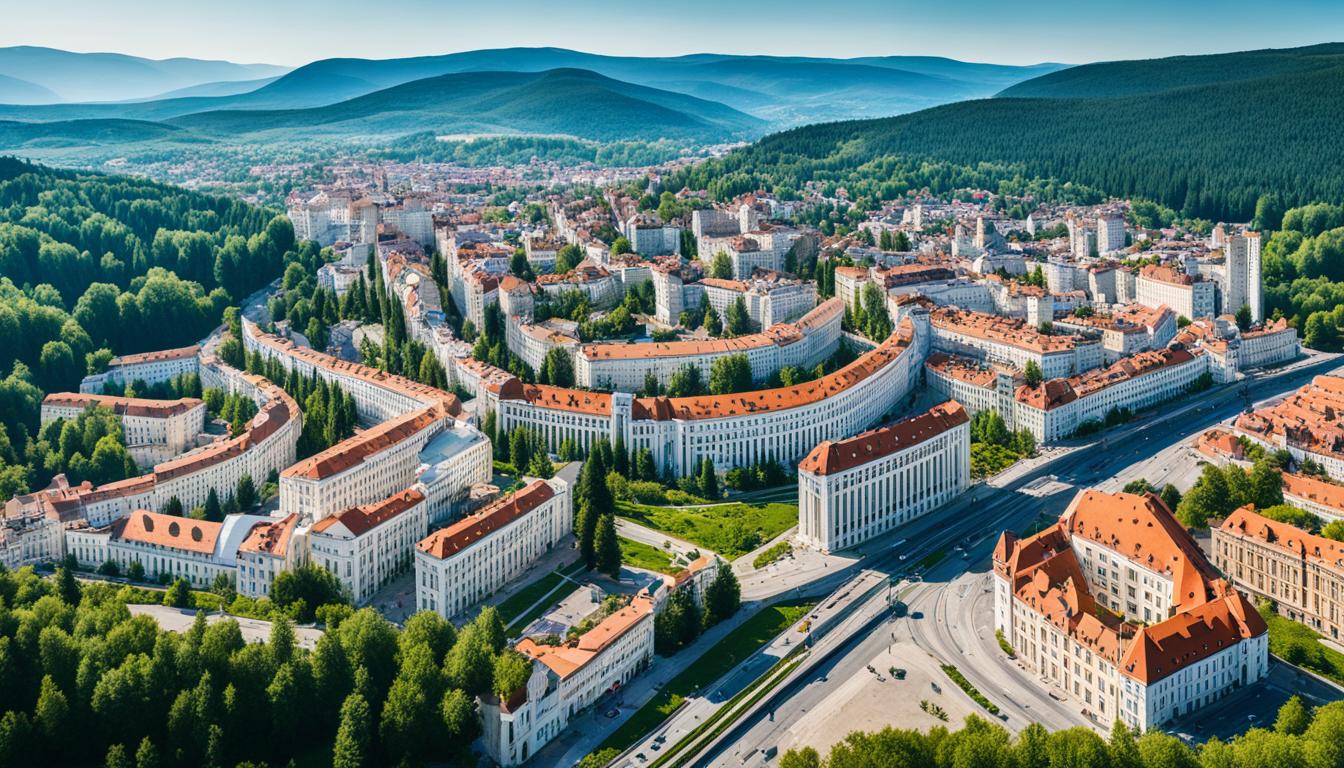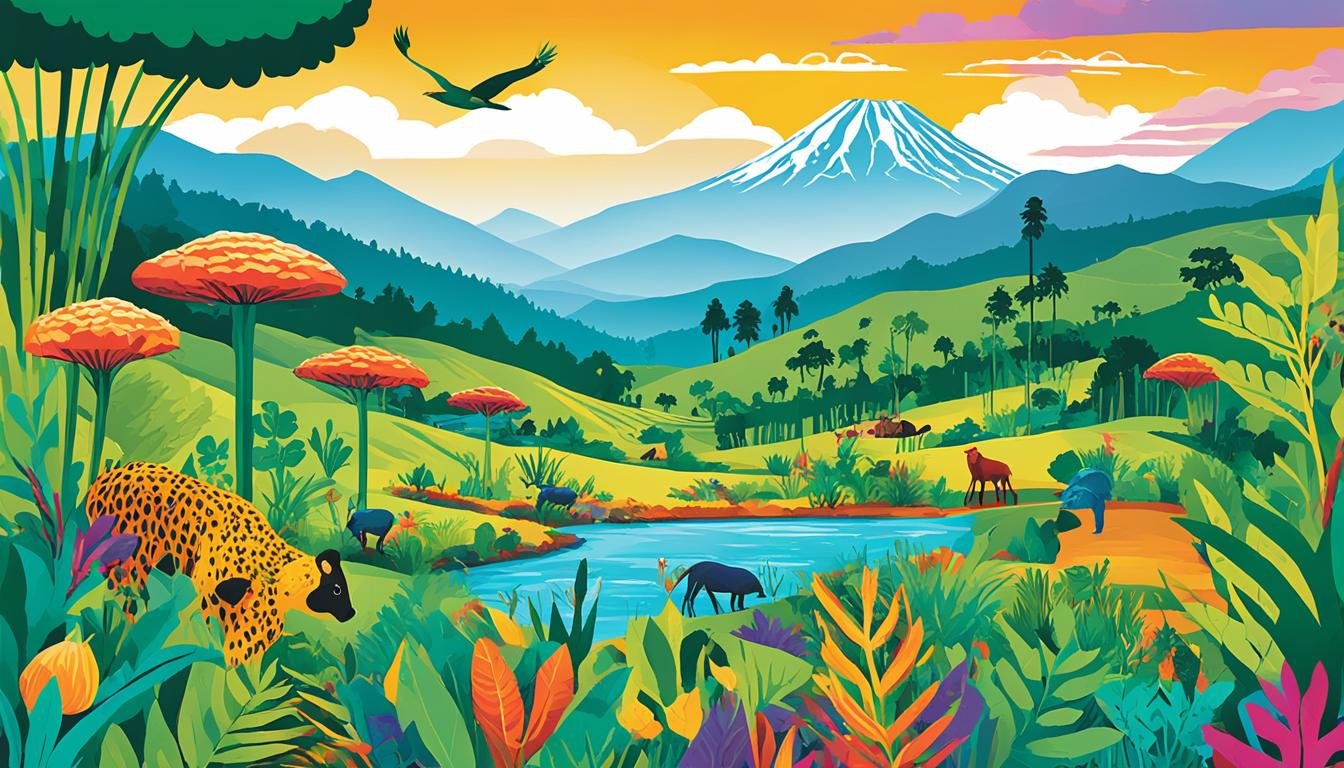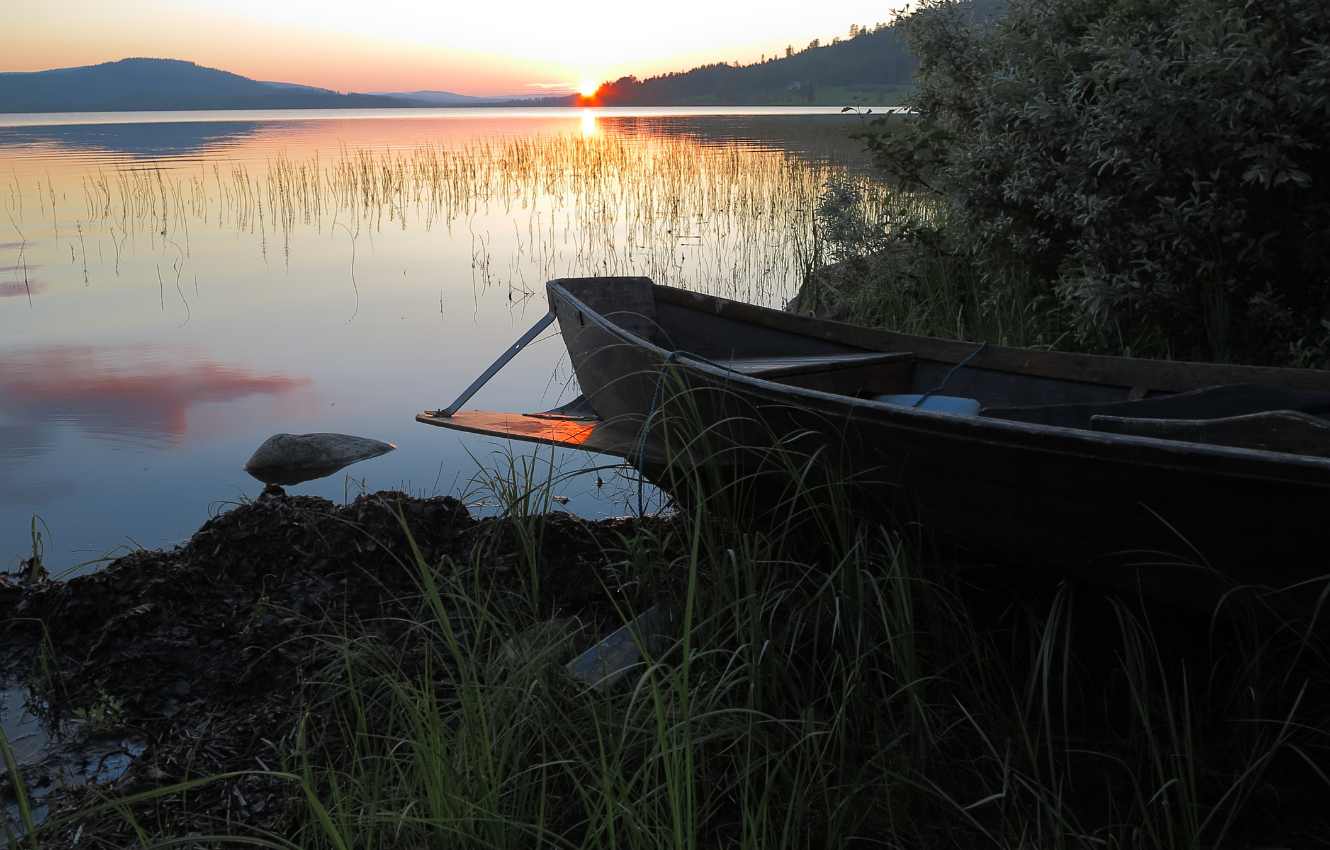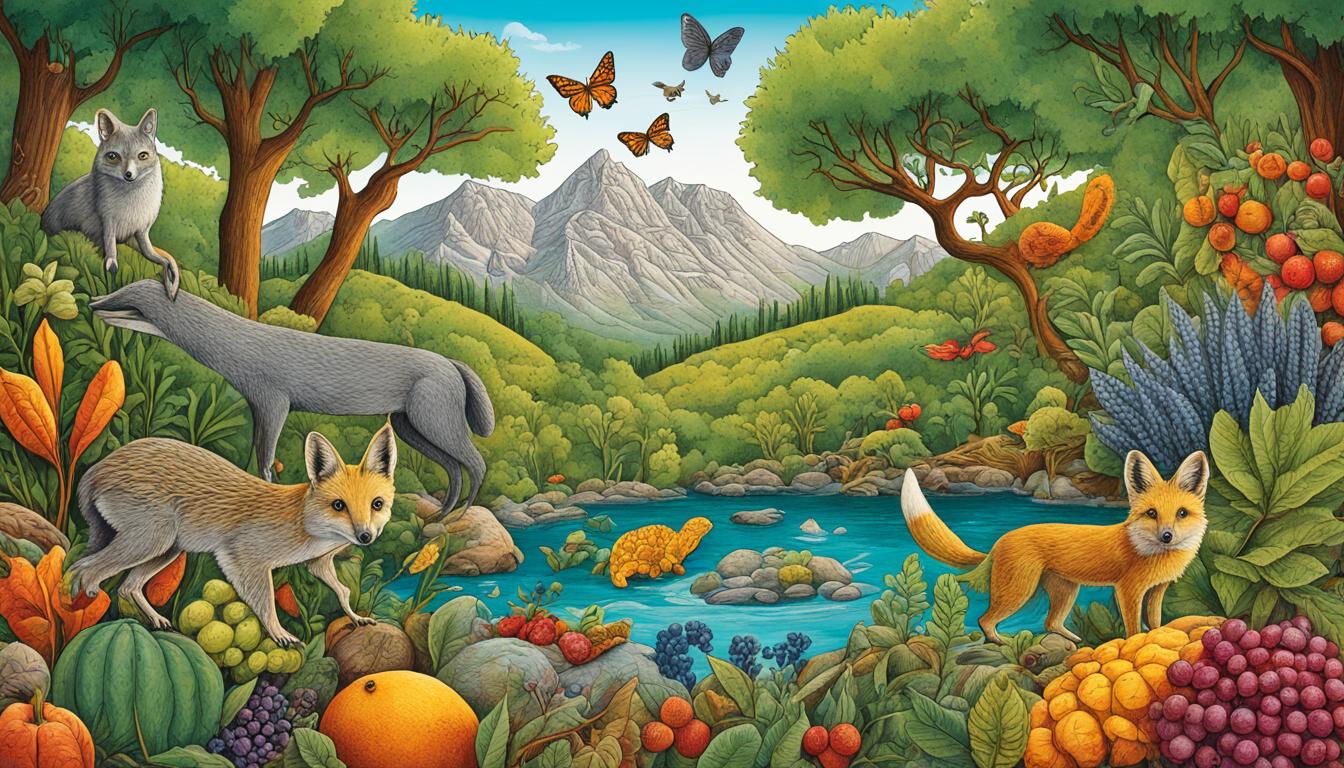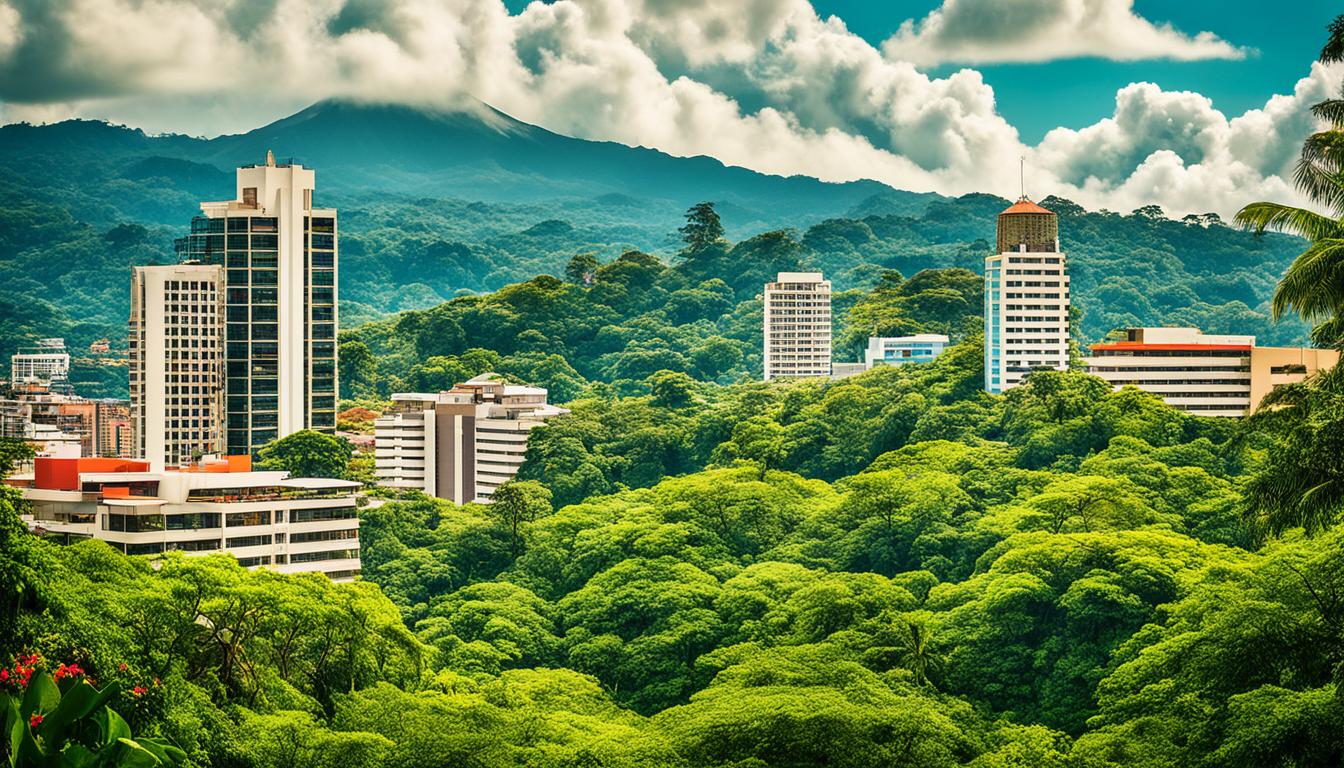Russia Biodiversity and the Built Environment
Did you know that Russia, the largest country in the world, spans diverse ecosystems including polar deserts, tundra, forests, steppe, and subtropics? With its vast territory, Russia is home to a remarkable variety of plant and animal species, making it a crucial hub for global biodiversity conservation.
Russian ecology and urban planning, sustainable construction practices, and environmental conservation efforts in Russian cities are all essential for preserving the country’s unique biodiversity. From biodiversity enhancement in Moscow’s architecture to the development of green infrastructure in St. Petersburg, Russia is taking strides to ensure the harmonious coexistence of nature and the built environment.
Key Takeaways:
- Russia’s vast size and diverse ecosystems make it a significant player in global biodiversity conservation.
- Sustainable construction practices and ecological design in Russian urban areas are crucial for maintaining the balance between the built environment and nature.
- Conservation efforts in Russian cities, such as biodiversity enhancement in architecture and the development of green infrastructure, contribute to urban biodiversity development.
- Russia actively participates in over 50 biodiversity conservation agreements, playing a pivotal role in safeguarding the planet’s ecosystems.
- Collaboration and support from the international community are crucial in preserving Russia’s biodiversity and mitigating the impacts of threats and challenges.
Biodiversity in Russia: Plant and Animal Species
Russia is renowned for its rich biodiversity, encompassing a vast array of plant and animal species. Let’s explore the fascinating flora and fauna that thrive in the diverse ecosystems of this expansive country.
Plant Species in Russia
Russia is home to approximately 12,500 species of vascular plants, showcasing a remarkable botanical diversity. From the Arctic tundra to the subtropical regions, the Russian landscape harbors a wide variety of plant life. The country’s vast forests cover 22% of the world’s forest resources, contributing significantly to global biodiversity.
Some notable plant species found in Russia include:
- Siberian Fir (Abies sibirica)
- Edelweiss (Leontopodium alpinum)
- Sundew (Drosera spp.)
- Siberian Pea Shrub (Caragana arborescens)
- Russian Sage (Perovskia atriplicifolia)
Animal Species in Russia
Russia’s diverse and abundant ecosystems provide habitats for a wide variety of animal species. From mammals and birds to reptiles, amphibians, fish, and invertebrates, Russia’s fauna is both captivating and diverse. Let’s explore some of the incredible animal life found in Russia.
1. Mammals: Russia is inhabited by over 320 species of mammals, ranging from majestic predators to elusive creatures. Some iconic species include:
- Siberian Tiger (Panthera tigris altaica)
- Polar Bear (Ursus maritimus)
- Siberian Musk Deer (Moschus moschiferus)
- Amur Leopard (Panthera pardus orientalis)
- Brown Bear (Ursus arctos)
2. Birds: With more than 732 species of birds, Russia offers birdwatchers and nature enthusiasts a true paradise. Some notable avian species found in Russia include:
- Steller’s Sea Eagle (Haliaeetus pelagicus)
- Siberian Crane (Leucogeranus leucogeranus)
- Black Grouse (Lyrurus tetrix)
- Gyrfalcon (Falco rusticolus)
- Golden Eagle (Aquila chrysaetos)
3. Reptiles and Amphibians: Russia boasts diverse populations of reptiles and amphibians, contributing to its overall biodiversity. Some notable reptile and amphibian species include:
- European Adder (Vipera berus)
- Common Garter Snake (Thamnophis sirtalis)
- Siberian Salamander (Salamandrella keyserlingii)
- Common Toad (Bufo bufo)
- Fire-bellied Toad (Bombina spp.)
4. Fish: Russia hosts a remarkable variety of fish species in its freshwater and marine environments. Some notable fish species include:
- Beluga Sturgeon (Huso huso)
- Pike (Esox lucius)
- Atlantic Salmon (Salmo salar)
- Caspian Lamprey (Caspiomyzon wagneri)
- Arctic Char (Salvelinus alpinus)
5. Invertebrates: Russia exhibits a high level of invertebrate diversity, with a multitude of insects, spiders, and other fascinating species. It is home to various stunning butterflies, beetles, and bees, contributing to the overall richness of its biodiversity.
Additionally, approximately 1,100 rare and endangered plant and animal species in Russia are included in the Red Book of the Russian Federation. This comprehensive list highlights the importance of conservation efforts to safeguard these vulnerable species and their habitats.
tag without additional attributes. The alt attribute should contain the keyword “Biodiversity in Russia: Plant and Animal Species”.
Threats to Russia’s Biodiversity
Russia’s diverse ecosystems and abundant biodiversity are facing numerous threats that jeopardize their long-term survival. Pollution, anthropogenic activities, climate change, land degradation, and habitat loss all contribute to the decline of Russia’s unique flora and fauna.
Pollution in Russia
The unchecked pollution in Russia poses a significant threat to its biodiversity. Major cities like Moscow and St. Petersburg suffer from high levels of air pollutants, primarily caused by outdated power plants and minimal environmental regulations on motor vehicles. Stricter air quality standards are necessary to combat this issue and safeguard Russia’s natural habitats.
Habitat Loss and Land Degradation in Russia
Habitat loss and land degradation are major contributors to the decline of biodiversity in Russia. The expansion of agriculture, urbanization, and industrial activities have resulted in the destruction and fragmentation of natural habitats, particularly affecting steppe ecosystems and broad-leaved forests. Efforts to protect these vulnerable areas are crucial for preserving biodiversity.
Climate Change and its Impact on Biodiversity
Climate change poses a serious threat to Russia’s biodiversity. Rising temperatures, changing precipitation patterns, and melting permafrost have profound implications for the survival of many plant and animal species. Adaptation strategies and conservation efforts are essential to mitigate the adverse effects of climate change and maintain the ecological balance.
Invasive Species in Russia
The introduction of invasive species poses a significant threat to Russia’s native flora and fauna. These non-native species can outcompete and displace indigenous species, disrupting ecosystems and leading to a loss of biodiversity. Effective management and control measures are necessary to prevent further damage caused by invasive species.
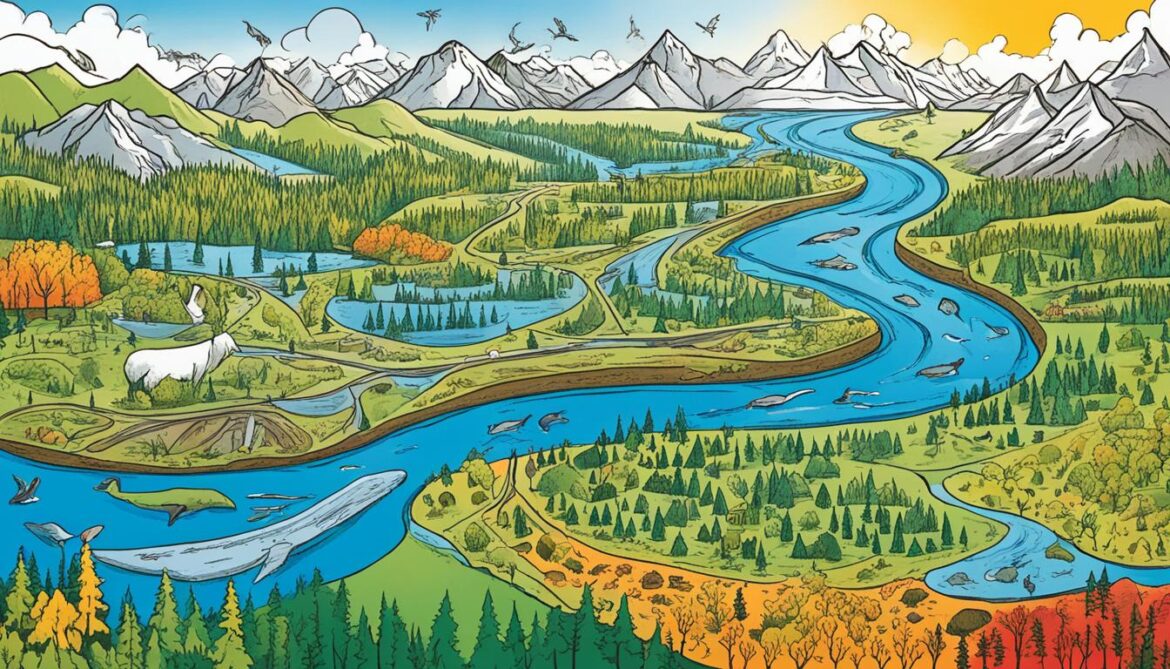
Impact of the Invasion of Ukraine on Conservation Efforts
The invasion of Ukraine has had far-reaching consequences for Russia’s biodiversity conservation. It has disrupted international cooperation and isolated Russia from key agreements, hampering collaborative conservation efforts. Restoring international cooperation is vital for the effective protection of Russia’s biodiversity.
Summary of Threats
Threats such as pollution, habitat loss, climate change, land degradation, and invasive species pose significant challenges to Russia’s biodiversity. Collaborative efforts, strict regulations, and sustainable practices are essential to overcome these threats and preserve Russia’s rich natural heritage.
| Threats to Russia’s Biodiversity | Pollution in Russia | Habitat Loss and Land Degradation | Climate Change | Invasive Species |
|---|---|---|---|---|
| Overview | Air pollution from outdated power plants and motor vehicles | Loss and degradation of natural habitats | Adverse effects on species due to rising temperatures and melting permafrost | Introduction of non-native species disrupting ecosystems |
| Impact | Higher respiratory illnesses, ecosystem contamination | Fragmentation, displacement, and extinction of species | Shifts in species distribution, loss of specialized habitats | Competition, predation, and loss of native biodiversity |
| Solutions | Implementation of stricter air quality standards, adoption of cleaner technologies | Protected areas establishment, habitat restoration, sustainable land use practices | Development of adaptation strategies, promotion of renewable energy sources | Monitoring and control measures to prevent further spread |
Importance of Russia in Global Biodiversity Conservation
Russia plays a crucial role in global biodiversity conservation due to its vast size and diverse ecosystems. With more wilderness, boreal forests, and peatlands than any other country, Russia serves as a critical stronghold for preserving plant and animal species and maintaining the integrity of ecosystems.
In addition, Russia actively participates in over 50 biodiversity conservation agreements, showcasing its commitment to protecting and conserving the environment. As the current chair of the Arctic Council, Russia also plays a pivotal role in safeguarding the fragile ecosystems and diverse wildlife of the Arctic region, ensuring its sustainability for future generations.
The conservation efforts in Russia not only contribute to the protection of its unique flora and fauna but also have a global impact. By preserving the biodiversity within its borders, Russia helps to maintain the balance of the global ecosystem and supports the overall goal of global biodiversity conservation.
| Key Points | |
|---|---|
| Russia’s vast size and diverse ecosystems | Preserves plant and animal species |
| Active participation in over 50 biodiversity conservation agreements | Safeguards fragile ecosystems of the Arctic region |
| Contributes to global biodiversity conservation | Maintains balance of the global ecosystem |
Russia’s Role in Global Biodiversity Conservation
“Russia’s unique natural resources and commitment to conservation make it an essential partner in global biodiversity conservation efforts. By protecting its diverse ecosystems and preserving threatened species, Russia contributes to the overall goal of preserving the planet’s biodiversity for future generations.” – Dr. Anna Petrov, Biodiversity Conservation Expert

Conservation Efforts in Russia
Russia has implemented various conservation efforts to protect its rich biodiversity. These initiatives include the establishment of protected areas throughout the country, such as national parks and nature reserves, aimed at preserving critical habitats and ensuring the survival of endangered species.
Furthermore, research centers dedicated to the study and conservation of endangered animal species play a crucial role in gathering scientific knowledge and implementing effective conservation strategies. These centers collaborate with international organizations to share information and best practices in biodiversity conservation.
Ex situ conservation methods, such as gene banks and captive breeding programs, are also employed in Russia to combat the decline of endangered species and ensure their long-term survival.
Despite the challenges, Russia remains committed to enhancing biodiversity conservation within its borders, recognizing the importance of protecting its unique ecosystems and contributing to global sustainability.
Impacts of Russia’s Invasion of Ukraine on Biodiversity Conservation
The invasion of Ukraine by Russia has had detrimental impacts on biodiversity conservation, particularly in Russia. The conflict has led to the isolation of the country, hindering international cooperation in preserving and protecting biodiversity. The disruption of cooperation has made it challenging to implement effective conservation strategies, as resources and attention have been diverted to address the war and its consequences.
Changes in policy priorities have further exacerbated the challenges in biodiversity conservation. With shifting focus towards the conflict, the allocation of resources and efforts towards protecting endangered species and habitats in Russia has been compromised. This diversion of attention creates an urgent need to reevaluate and reinstate the importance of biodiversity conservation as a priority.
Funding and information sharing have also been significantly impacted by the invasion, posing further challenges in biodiversity conservation. Limited financial resources are available for conservation efforts, making it difficult to allocate adequate funds towards initiatives aimed at protecting and preserving endangered species and their habitats. In addition, the disruption in communication and collaboration with international partners has hindered the sharing of crucial data and knowledge that is vital for effective conservation strategies.
Given the severity of the situation, collaboration and support from the international community are crucial in mitigating the impacts of the invasion and preserving Russian biodiversity. International partnerships can provide much-needed resources, expertise, and advocacy to help address the challenges faced in biodiversity conservation within the country. Through concerted efforts, it is possible to develop and implement effective conservation measures that can safeguard endangered species and their habitats despite the ongoing conflict.
Measures to Enhance Implementation of Biodiversity Conservation in Russia
Russia recognizes the importance of biodiversity conservation and has implemented various measures to safeguard its diverse ecosystems and wildlife. These efforts aim to protect endangered species, promote sustainable development, and ensure the long-term health of Russia’s natural environment.
Protected Areas in Russia:
Russia has established a comprehensive network of protected areas throughout the country. These areas serve as sanctuaries for a wide range of plant and animal species, preserving their habitats and preventing further degradation. From national parks to nature reserves, these protected areas play a crucial role in biodiversity conservation in Russia.
Regulations from the Red Book of the Russian Federation:
The Red Book of the Russian Federation is a key resource in the country’s biodiversity conservation efforts. It contains a comprehensive list of rare and endangered species, along with regulations and guidelines for their protection. By enforcing the regulations outlined in the Red Book, Russia aims to mitigate threats to these vulnerable species and ensure their survival.
Research Centers in Russia:
Russia is home to specialized research centers dedicated to the study and conservation of endangered animal species. These centers conduct valuable research, monitor population trends, and develop conservation strategies to safeguard vulnerable species. Through their work, these research centers contribute to a better understanding of Russia’s biodiversity and inform conservation efforts.
Ex Situ Conservation Methods:
Ex situ conservation methods, such as gene banks, are implemented in Russia to combat the decline of endangered species. Gene banks store genetic material from endangered plants and animals, preserving their genetic diversity and providing a potential resource for future reintroduction or breeding programs. These methods supplement in situ conservation efforts and provide a safety net for species facing immediate threats.
Despite these conservation measures, challenges remain in enhancing biodiversity conservation in Russia. Adequate funding for national conservation programs is crucial to support ongoing efforts. Additionally, international collaboration and knowledge sharing are essential to address conservation challenges and promote the sustainable management of Russia’s biodiversity.

Examples of Protected Areas in Russia
| Protected Area | Location | Size (km²) | Key Species |
|---|---|---|---|
| Zapovednik Lena Pillars | Sakha Republic | 1,217 | Siberian musk deer, black stork |
| Kronotsky Nature Reserve | Kamchatka | 10,990 | Brown bear, Steller’s sea eagle |
| Wrangel Island Reserve | Chukotka Autonomous Okrug | 7,608 | Polar bear, Pacific walrus |
| Valdai National Park | Novgorod Oblast, Tver Oblast, Pskov Oblast | 3,057 | European bison, bear, lynx |
“Conservation is a collective effort that requires active participation from government agencies, research institutions, and the local communities. By implementing these measures, Russia is taking important steps towards enhancing biodiversity conservation and ensuring a sustainable future for its natural heritage.”
Challenges and Opportunities in Biodiversity Conservation Governance in Russia
The conservation of biodiversity in Russia presents both distinctive challenges and remarkable opportunities. The invasion of Ukraine has introduced new complexities within the energy market, necessitating a reassessment of the transition to renewable energy sources. Notably, concerns have emerged regarding the war’s impact on the climate, energy sector, food production, and biodiversity in the region.
Russia’s economic difficulties further compound the obstacles encountered in cleaning up and repairing environmental damage. Despite these challenges, the government emphasizes the paramount importance of ecosystems in addressing climate and biodiversity issues.
“Preserving our biodiversity is not just an ecological imperative, but a socioeconomic necessity. The well-being and prosperity of our nation are interconnected with the health and preservation of our natural environment.”
Challenges in Biodiversity Conservation Governance:
- Invasion of Ukraine impacting international cooperation and hindering implementation of conservation strategies
- Issues with funding and information sharing, hampering efforts to protect endangered species
- Complexity of cleaning up and repairing environmental damage due to economic constraints
Opportunities in Biodiversity Conservation Governance:
- Increased focus on renewable energy transition and sustainable practices
- Recognition of the intrinsic value of ecosystems in addressing climate and biodiversity challenges
- Potential for international collaboration and support in mitigating the impacts of the invasion and preserving Russian biodiversity
To overcome these challenges and capitalize on the opportunities, Russia must prioritize environmental protection and implement effective governance strategies that promote biodiversity conservation while addressing socioeconomic realities.

Table: Challenges and Opportunities in Biodiversity Conservation Governance in Russia
| Challenges | Opportunities |
|---|---|
| Invasion of Ukraine | Increased focus on renewable energy transition |
| Issues with funding and information sharing | Recognition of the intrinsic value of ecosystems |
| Economic constraints in addressing environmental damage | Potential for international collaboration and support |
Air Pollution in Russia
Air pollution poses a significant challenge in several major Russian cities, including Moscow and St. Petersburg. With the rapid industrialization and urbanization, the country’s air quality has been compromised, impacting both human health and the surrounding environment.
One major contributing factor to air pollution in Russia is the outdated infrastructure of power plants. Most power plants lack modern pollution control equipment, resulting in large amounts of toxic emissions and waste being released into the atmosphere. These emissions contribute to the deterioration of air quality and pose serious health risks to the population.
In addition to power plants, motor vehicles also contribute to air pollution in Russia. Many vehicles in the country are subject to minimal environmental regulations, leading to higher emissions of harmful pollutants. The combined effects of power plants and motor vehicle emissions further worsen the air quality in major cities.
Recognizing the urgent need for action, stricter air quality standards are being implemented as environmental awareness grows in Russia. The government, along with environmental organizations, is working towards reducing air pollution and promoting sustainable practices. Efforts such as improving pollution control technology, promoting electric vehicles, and implementing stricter emission standards for industries are being undertaken to mitigate the adverse effects of air pollution.
“Addressing air pollution is crucial for safeguarding public health and protecting the environment. The growing emphasis on stricter regulations and sustainable practices will play a significant role in improving air quality in Russia.”
Major Russian Cities Affected by Air Pollution
Air pollution is particularly prominent in major Russian cities, where industrial activities and high population densities contribute to the problem. Here are some of the cities most affected by air pollution:
- Moscow
- St. Petersburg
- Novosibirsk
- Yekaterinburg
- Kazan
These cities face unique challenges in managing air pollution due to their large populations and industrial activities. Efforts to mitigate pollution and improve air quality are crucial to safeguard the health and well-being of the residents.
Power Plants and Toxic Emissions in Russia
| Power Plant | Toxic Emissions |
|---|---|
| Severstal Power Plant, Cherepovets | High emissions of sulfur dioxide (SO2) and nitrogen oxides (NOx) |
| Leningrad Nuclear Power Plant, Sosnovy Bor | Risk of radioactive contamination in case of accidents |
| Moscow Combined Heat and Power Plants | Emissions of particulate matter and greenhouse gases |
| Bratsk Hydroelectric Power Station, Bratsk | Altered flow patterns and impacts on aquatic biodiversity |
| Volgograd Thermal Power Plant, Volgograd | Emissions of sulfur dioxide (SO2) and nitrogen oxides (NOx) |
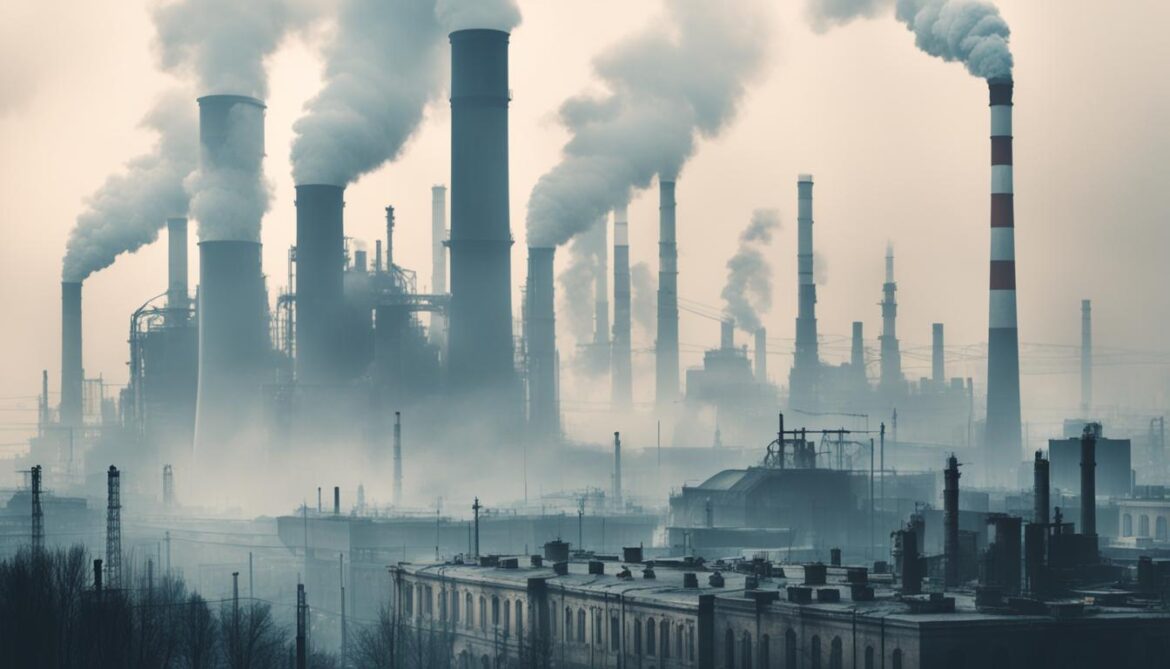
These power plants are among the many in Russia that contribute to the country’s air pollution problem. Efforts to upgrade these facilities and implement stricter pollution control measures are essential to reduce toxic emissions and preserve air quality.
Oil and Natural Gas Issues in Russia
The oil and gas industry in Russia plays a significant role in the country’s economy, but it also poses environmental challenges related to pollution and biodiversity conservation. The development and extraction of oil and natural gas contribute to air pollution, making them major sources of pollution in Russia.
One of the most concerning environmental issues associated with the oil and gas industry in Russia is the occurrence of oil spills and leakages from pipelines and refineries. These incidents result in the contamination of vast areas, including Siberian rivers, with detrimental effects on the surrounding ecosystems and biodiversity.
Moreover, the pollution caused by oil spills has been linked to health problems in the affected regions. The exposure to toxic substances can have severe consequences for both human and animal populations, endangering their well-being and survival.
The environmental impacts of oil and gas development have raised concerns about sustainability and hindered the growth of these sectors. The negative consequences of pollution and the potential harm caused to Russia’s biodiversity call for increased efforts in implementing stricter regulations and adopting environmentally-friendly practices within the industry.
| Environmental Impacts | Examples |
|---|---|
| Air Pollution | Contribution to air pollution due to emissions from oil and gas extraction activities |
| Oil spills | Contamination of Siberian rivers and surrounding ecosystems |
| Health Problems | Reported health issues resulting from exposure to oil pollution |
| Environmental Concerns | Threat to biodiversity and hindrance to sustainable growth |
Addressing the environmental impact of the oil and natural gas industry in Russia is crucial for the protection and conservation of the country’s rich biodiversity. Environmental regulations, technological advancements, and responsible practices can contribute to minimizing pollution and safeguarding the integrity of Russia’s ecosystems.
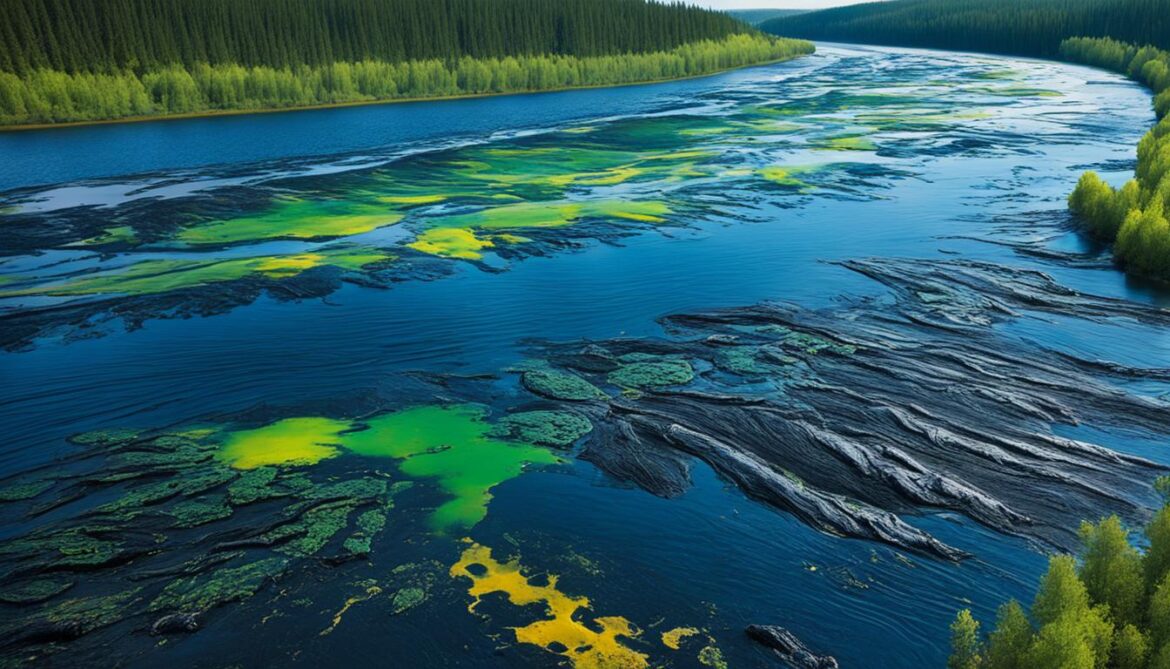
Conclusion
Russia’s vast territory and diverse ecosystems make it a significant player in global biodiversity conservation. The country is home to a wide range of plant and animal species, and its forests cover a significant portion of the world’s forest resources. However, Russia also faces numerous challenges in preserving its biodiversity. Pollution, habitat loss, and climate change pose significant threats to the country’s ecosystems.
Conservation efforts and international cooperation are crucial in protecting endangered species and maintaining the integrity of Russian ecosystems. Despite the impacts of the invasion of Ukraine, the government and relevant stakeholders in Russia continue to work towards enhancing biodiversity conservation. Special focus is now placed on measures to enhance the implementation of conservation practices, such as the establishment of protected areas and research centers.
In conclusion, Russia’s biodiversity and the built environment are closely intertwined. Preserving biodiversity plays a crucial role in maintaining the balance of plant and animal species, as well as the overall health of the environment. Through the collective efforts of conservationists, policymakers, and the international community, Russia can continue to be a key contributor to global biodiversity conservation.




